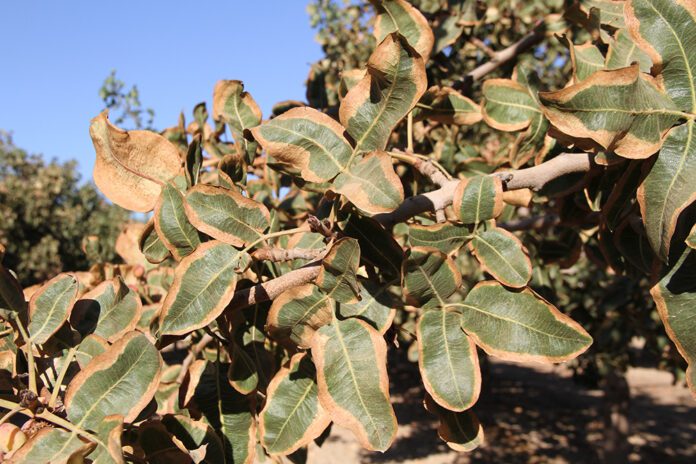
Like the macronutrients nitrogen, phosphorus and potassium, the micronutrient boron (B) also plays an essential role as a plant nutrient crucial for growth and productivity. In California, B was first identified as a deficiency. If an August leaf analysis is below 90 ppm B, the inflorescences die or produce aborted nuts. If an August leaf analysis is below 60 ppm B, leaves will become thickened, distorted and the dull green shown in the photo of Figure 1.
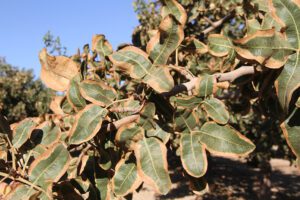
Currently, excess B in soils and water are producing B toxicity. The symptom, shown in the bottom photo of Figure 1, is a mid-season leaf edge necrosis that increases in area through harvest. Depending upon the multiple factors of soil texture, pH, ECe, B concentration in soil and water, ETc and rootstock and scion, B can quickly transition from deficiency to toxicity in pistachio. However, unlike B deficiency, for which the cause has been determined and is easily corrected, the cause of B toxicity is unknown and less easily corrected.
Boron’s Function
B is considered the least understood plant nutrient. Pectin is a major component of plant cell walls. B crosslinks the pectin molecules within the cell walls, ensuring proper cell wall development of the plant meristems, the root and shoot tips. B is also essential for phloem development, the living tissue in vascular plants that transports the soluble sugars produced by photosynthesis to the growing shoot and root tips. Therefore, B is not only essential as a structural component of cell walls, it indirectly supports the delivery of sugars essential for the cell wall extension growth.
B is also essential for pollen receptivity of the stigma, the sticky flower structure where pollen lands, germinates and then transports sperm cells down the style to the female ovules, or eggs via the pollen tube. If B is insufficient, the pistachio inflorescence, the compound flower, will either die or fertilization will fail, resulting in less yield and a higher percentage of blank, empty nuts.
B also affects nitrate reductase activity, precipitating N deficiencies. Nitrate reductase is the first step in converting nitrate absorbed from the soil to usable N within a plant. Both B deficiency and excess potentially decrease the efficiency of N fertilization by preventing this conversion.
Boron’s Sources and Availability in Soils, and Transport in Pistachio
To understand why B moves so quickly from a deficiency to toxicity in pistachio, the soil sources and availability of B, and B transport in pistachio, need to be understood. The soils of the lower west side of the San Joaquin Valley are derived from the sediments of the Coastal Range, which have marine origins and are rich in B, sodium and chloride. The streams from the eastern slopes of this range have B levels up to 25 ppm (25 mg/L), adding additional B. The U.S. Geological Survey estimates the B in the Southern and Central California groundwater basins at >1 ppm (1 mg/L). These groundwater basins have no subsurface drainage to the sea; B not taken up by plants accumulates in the soil. Therefore, the soil and water B levels are typically so high on the western side of the San Joaquin Valley that B fertilization is unnecessary.
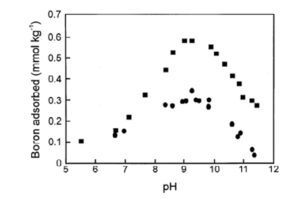
In soils up to pH 10, B exists as boric acid, B(OH)3, and is adsorbed on the surfaces of clay minerals, iron oxides, aluminum, lime and soil organic matter. Finer-textured dry soils with higher organic matter and lime (calcium oxide, CaO) can adsorb and retain more B on their exchange sites and within their soil lattice structure. Therefore, B availability decreases with higher soil pH and lower soil moisture (Figure 2). B availability is greater in coarser, wet, warm soils with low lime and organic matter contents. At pH>10, the easily assimilated B(OH)3 is converted to the anion form, B(OH)4, which cannot be absorbed by root membranes and therefore uptake is decreased even though adsorption is decreased.
The origin, forms and availability of B in Central Valley soils and water described explain why boron can quickly transition from deficiency to toxicity in pistachio. When the soil B pool is sufficient or excessive, uptake into the pistachio roots is passive and follows the concentration gradient. The plant cannot regulate it in any way. Therefore, if a soil has high B content (2 to 4 ppm), a pH of 7 or less, high available water content and the soil is warm, B uptake increases. Even normal irrigation can increase the availability of the loosely held boron in the soil. However, as soil salinity rises, increasing osmotic pressure and decreasing water uptake, B uptake is also decreased. Surprisingly, recent research suggests pistachios transition from passive to active (spending metabolic energy) uptake when soil B levels and availability are low.
The final factor in understanding why B can move so quickly from deficiency to toxicity in pistachio is related to how B is transported within a pistachio tree. After passive uptake, B is transported only in the xylem and accumulates at the point of transpiration: the leaves. B is physiologically ‘immobile’ in pistachio because it is incapable of distributing the B via the phloem to actively growing plant tissues, such as roots, shoots and blooming inflorescences. Phloem immobility is caused in plants that produce low levels of polyols. Polyols are sugar alcohols, such as mannitol, sorbitol and myo-inositol. B-mobile plants complex B with these polyol sugars to allow its transport in the phloem. Pistachio, walnut, pecan, tomato and strawberry are all phloem-immobile plants. Almond, peach, apricot, plum, cherry, apple, pear, grape, pomegranate and olive are phloem-mobile and can supply B and other nutrients to rapidly developing plant tissue for the critical periods of high demand. Dr. Patrick H. Brown’s early pistachio research on failed bloom and fruit set of pistachio revealed both inadequate soil boron and its phloem immobility compounded the effects of this micronutrient deficiency. He demonstrated August leaf levels of 150 to 250 ppm were required for successful bloom and vegetative shoot growth. B’s effects on pistachio root growth have not yet been investigated.
In summary, soil and ground water B levels are generally high in California’s best pistachio-producing regions. It exists primarily as boric acid and is adsorbed on clay surfaces and organic matter. Increases in soil pH>7 and ECe as well as lower soil moisture decrease B availability. Increasing soil temperature and soil moisture increase boron availability. In soils with high available B, uptake is a function of its concentration and cannot be controlled by the plant. Once in the plant, the B moves in the xylem transportation stream only and accumulates at the point of maximum transpiration, producing visible B toxicity.
If sufficient B has not accumulated in the flower buds the previous year, B deficiency results in inflorescence abscission and poor fruit set. This is due to the short, rapid and critical need for B at this critical stage of pollination and fruit set. The phloem immobility of B, minimal canopy development for transpiration during bloom and low soil temperature all decrease early season B transport and availability. This is why a pre-bloom budswell spray of 5 lbs Solubor/ac in 100 gal/ac is recommended to meet this high and critical B demand period.
Boron Deficiency
B deficiency was first identified early in California pistachio production by Dr. Kay Uriu and Madera County UCCE Farm Advisor Rocky Teranishi, and was easily corrected and not a major problem. They determined an August critical leaf level threshold of 90 ppm. It became a major problem when the Pistacia integerrima rootstock, Pioneer Gold I, PGI and its hybrid, Pistacia atlantica x Pistacia integerrima, University of California I, UCBI, were widely planted. The reproductive symptoms were inflorescence death, failure to set nuts and aborted nuts. Brown’s research determined a 150- to 250-ppm sufficiency range was required for successful pollination, fruit set and vegetative shoot growth.
Correcting B deficiency is easy. B fertilization practices depend upon the soil B content, texture, pH and ECe and B content of the water. A typical B fertilization program would be Solubor (21.7% B) at 15 lbs/ac applied through the drip system through the first year. In the following years, B is applied as a spray at 3 lbs Solubor/ac at 50% leaf expansion mid to late April in combination with Copper EDTA at 0.5 lb/ac and Zinc 36% product. To improve fruit set under marginal B levels, spray 5 lbs Solubor/ac in 100 gal/acre at the delayed dormant budswell period. In many areas of the southern San Joaquin Valley where soils are naturally high in B, fertilization is not necessary.
Boron Toxicity
Managing B toxicity is more difficult than correcting deficiency because it is poorly understood. B toxicity symptoms in pistachio are confined to necrosis at the leaf edge. In the past two decades, visible boron toxicity in pistachio has greatly increased. Reasons for this increase are more pistachio plantings in saline sodic soils also high in B, limited good-quality surface water for leaching, increased use of groundwater high in B, drought and greater sensitivity of the ‘Golden Hills’ cultivar.
The mechanism of B toxicity is unknown. B toxicity in pistachio does reduce leaf area and, logically, leaf photosynthetic capacity, and by extension should reduce yield. However, significant correlations among soil B levels, August leaf levels, the degree of B toxicity symptoms and yield have not been experimentally established.
In our current research trial examining combinations of irrigation hose configuration and leaching methods to decrease soil salinity, we have also begun to examine the effect of B soil levels on leaf B levels, toxicity symptoms and yield.
Recent Research Results
Does soil B level correlate with leaf B levels, leaf damage and edible yield?
We found a strong, statistically significant negative correlation (r = 0.70) between soil B levels and the total edible yield of pistachio (Figure 3a). When soil B levels were below 5 ppm, eighth-leaf Golden Hills on a UCBI clonal rootstock produced an average ~4000 lbs/acre yield. When soil B levels rose to 5 to 10 ppm, average yields dropped by 30% to ~3000 lbs/acre. These yields were produced with average leaf levels of 1000 ppm B (Figure 3b) and an average of 15% necrotic leaf area. However, we found poor and statistically insignificant correlations of leaf ppm B and % necrotic leaf area as a function of soil B levels (Figures 3b and 3c). Collectively, these results confirm the current recommendation to maintain soil B levels below 5 ppm B. However, the results also suggest a leaf level up to 750 ppm does not decrease yield and the % necrotic leaf area is a poor indicator of soil B levels.
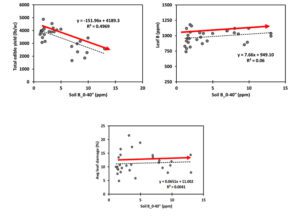
Does leaf B level correlate with edible yield, leaf damage and leaf damage with yield?
Analysis of edible yield as a function of ppm leaf B demonstrated a negative (but weak) and statistically insignificant correlation with yield; as leaf levels rose to >800 ppm, B yields dropped below 4000 lbs/acre and varied greatly (Figure 4a). However, we found a statistically significant positive correlation (r = 0.50) of % necrotic leaf area as a function of leaf B level but a poor, statistically insignificant correlation of yield as a function of percentage of % necrotic leaf area (Figure 4b). Below 1000 ppm leaf B, the average % necrotic leaf area remained below 10% (Figure 4b) but varied widely above 1000 ppm B.
Collectively, these results demonstrated a moderately positive correlation but statistically significant relationship between leaf B levels and % of necrotic leaf area. However, we found no correlations between % necrotic leaf area as a function of soil B and yield as a function % necrotic leaf area. This suggests the visible B toxicity produced late in the pistachio production season is not the direct cause of the yield declines produced by increasing soil boron levels. The data also demonstrates young pistachios can successfully produce economic yields at these soil and leaf B levels.
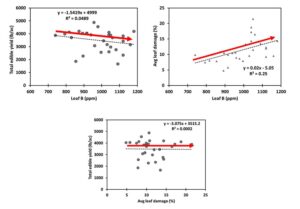
This Golden Hills on clonal UCBI rootstock orchard is producing normal yields for a ninth-leaf orchard entering full bearing. In 2022, eighth-leaf in <5 ppm B soils with ~955 ppm B leaf levels averaged 1073 lb/ac edible inshell splits. In 2023, ninth-leaf in <5 ppm B soils and 750 to 800 ppm leaf B averaged ~4,000 lb/ac. edible in-shell split yield. In 2023, above these soil and leaf B levels, yields varied greatly but averaged ~3,000- lb/ac edible in-shell split yield. This research is preliminary and ongoing. And, as noted, B’s effects from deficiency to toxicity depend upon availability which is a function of multiple factors, including soil texture, pH, ECe, boron concentration, ETc, rootstock and scion.
Our data demonstrate above 5 ppm, increasing soil B content decreases edible yield, but we could not demonstrate the decrease in yield was a function of increasing leaf B levels or % leaf area damage manifesting as B toxicity. This suggests the mechanism of increased soil B in decreasing yield is not produced by decreasing the photosynthetically active leaf area. This is new information and merits further investigation because, as noted, the mechanism of B toxicity damage is unknown. And it also suggests toxicity is not an accurate term for the visible leaf damage.















